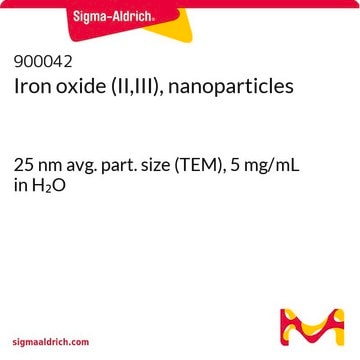The dispersant is an ethoxylated carboxylic acid. Please see the structure in the attached pdf file. The carboxylic acid is esterified, so the terminus, as shown, is an alcohol.
Wichtige Dokumente
720704
Eisen(III)-Oxid, Dispersion
nanoparticles, ≤110 nm particle size, 20 wt. % in H2O
Synonym(e):
Eisenoxid in Wasser
About This Item
Empfohlene Produkte
Form
nanoparticles
Konzentration
20 wt. % in H2O
Partikelgröße
≤110 nm
pH-Wert
6-8
Dichte
1.17 g/mL±0.1 g/mL at 25 °C
SMILES String
O=[Fe]O[Fe]=O
InChI
1S/2Fe.3O
InChIKey
JEIPFZHSYJVQDO-UHFFFAOYSA-N
Suchen Sie nach ähnlichen Produkten? Aufrufen Leitfaden zum Produktvergleich
Lagerklassenschlüssel
10 - Combustible liquids
WGK
nwg
Flammpunkt (°F)
Not applicable
Flammpunkt (°C)
Not applicable
Hier finden Sie alle aktuellen Versionen:
Besitzen Sie dieses Produkt bereits?
In der Dokumentenbibliothek finden Sie die Dokumentation zu den Produkten, die Sie kürzlich erworben haben.
Kunden haben sich ebenfalls angesehen
-
Product 720704 is a dispersion of iron(III) oxide particles in water. Is there also a dispersant present? If so, what is the structure of the dispersant?
1 answer-
Helpful?
-
-
What is the Department of Transportation shipping information for this product?
1 answer-
Transportation information can be found in Section 14 of the product's (M)SDS.To access the shipping information for this material, use the link on the product detail page for the product.
Helpful?
-
Active Filters
Unser Team von Wissenschaftlern verfügt über Erfahrung in allen Forschungsbereichen einschließlich Life Science, Materialwissenschaften, chemischer Synthese, Chromatographie, Analytik und vielen mehr..
Setzen Sie sich mit dem technischen Dienst in Verbindung.



